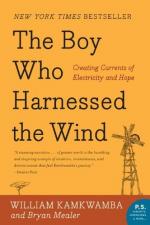|
This section contains 655 words (approx. 2 pages at 400 words per page) |

|
The Boy Who Harnessed the Wind: Creating Currents of Electricity and Hope Summary & Study Guide Description
The Boy Who Harnessed the Wind: Creating Currents of Electricity and Hope Summary & Study Guide includes comprehensive information and analysis to help you understand the book. This study guide contains the following sections:
This detailed literature summary also contains Topics for Discussion and a Free Quiz on The Boy Who Harnessed the Wind: Creating Currents of Electricity and Hope by William Kamkwamba.
This book is the inspiring autobiography of a Malawian teenager who, in spite of the challenges posed by drought, famine and poverty, designed and built a functioning electrical system in his family home and, as a result, became internationally recognized for his innovative work. As the narrative details the determination with which young William Kamkwamba struggled to make his dreams a reality, it also explores themes related to the value of friendship and the tension between magic and science.
The narrative begins with a short prologue in which William describes his first attempt at getting his windmill to work. The initial suspicion of the towns-people gathered to watch is quickly replaced by excitement and congratulatory enthusiasm when, as the blades of the windmill spin, the light bulb in William's hand (wired to the windmill) illuminates.
The narrative proper, which takes place mostly in the early years of the new millennium (1999-2007) begins with William telling several stories about magic, many of which, he says, were passed on from generation to generation within the family. He says that belief in such supernatural ways and beings shaped and defined life and relationships in the small Malawi farming communities where he grew up, communities that relied heavily on agriculture for both food and income. His narrative descriptions of the circumstances in which he lives, both in terms of his large family and of the community at large are accompanied by occasional references to difficulties of getting consistent power. These references foreshadow William's eventual interest in generating electricity for the purposes of making family life, and the process of farming, easier, more efficient, and more productive.
When William's dream of going to a good school is shattered by both bad grades and famine-triggered poverty, he starts spending his time in the local library in an effort to expand his education and increase his chances of getting into the kind of quality school he wants. This, he says, he wants to do so he can help his family and his community. During his time in the library, he develops an interest in science, and particularly in electricity, becoming fascinated with the possibility of building his own electrical system so he can first power his family's home consistently, and second, build things like a well, which would enable them to irrigate and therefore grow more and better crops. His initial experiments with radios and other electronic devices lead him to believe that it is possible for him to build the kind of machinery he has in mind, using designs self-adapted from those in his books and intended to make use of found materials. Still not in school, he starts regularly searching through the community scrap yard, eventually coming up with almost everything he needs. The assistance of his somewhat wealthier friend Gilbert takes care of the rest, and eventually, after a few errors, William constructs his windmill. At that point, the narrative returns to the Prologue and further portrays the community celebrating William's accomplishment at generating power.
Eventually, word of William's accomplishment spreads. In a relatively short period of time, he receives a substantial amount of publicity that, in turn, leads to an invitation to appear at a prestigious international conference on design and technological innovation. William's presentation is a hit, and afterwards he is invited to America for both a tour and another presentation. Back at home, now aware of the technological advancements taking place in the rest of the world, William continues to improve his inventions, making his mother's life, and the lives of everyone else in the community, much easier.
The narrative concludes with a description of what William's life has become in the few years since his invention first came into his mind - he has begun attending a school for young African leaders and innovators, and continues to believe in the value and possibilities of his home country, and his home continent.
Read more from the Study Guide
|
This section contains 655 words (approx. 2 pages at 400 words per page) |

|



